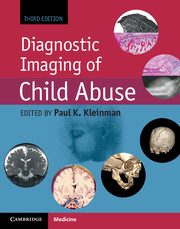Book contents
- Frontmatter
- Dedication
- Contents
- List of Contributors
- Editor’s note on the Foreword to the third edition
- Foreword to the third edition
- Foreword to the second edition
- Foreword to the first edition
- Preface
- Acknowledgments
- List of acronyms
- Introduction
- Section I Skeletal trauma
- Chapter 1 The skeleton: structure, growth and development, and basis of skeletal injury
- Chapter 2 Skeletal trauma: general considerations
- Chapter 3 Lower extremity trauma
- Chapter 4 Upper extremity trauma
- Chapter 5 Bony thoracic trauma
- Chapter 6 Dating fractures
- Chapter 7 Differential diagnosis I: diseases, dysplasias, and syndromes
- Chapter 8 Differential diagnosis II: disorders of calcium and phosphorus metabolism
- Chapter 9 Differential diagnosis III: osteogenesis imperfecta
- Chapter 10 Differential diagnosis IV: accidental trauma
- Chapter 11 Differential diagnosis V: obstetric trauma
- Chapter 12 Differential diagnosis VI: normal variants
- Chapter 13 Evidence-based radiology and child abuse
- Chapter 14 Skeletal imaging strategies
- Chapter 15 Postmortem skeletal imaging
- Section II Abusive head and spinal trauma
- Section III Visceral trauma and miscellaneous abuse and neglect
- Section IV Diagnostic imaging of abuse in societal context
- Section V Technical considerations and dosimetry
- Index
- References
Chapter 11 - Differential diagnosis V: obstetric trauma
from Section I - Skeletal trauma
Published online by Cambridge University Press: 05 September 2015
- Frontmatter
- Dedication
- Contents
- List of Contributors
- Editor’s note on the Foreword to the third edition
- Foreword to the third edition
- Foreword to the second edition
- Foreword to the first edition
- Preface
- Acknowledgments
- List of acronyms
- Introduction
- Section I Skeletal trauma
- Chapter 1 The skeleton: structure, growth and development, and basis of skeletal injury
- Chapter 2 Skeletal trauma: general considerations
- Chapter 3 Lower extremity trauma
- Chapter 4 Upper extremity trauma
- Chapter 5 Bony thoracic trauma
- Chapter 6 Dating fractures
- Chapter 7 Differential diagnosis I: diseases, dysplasias, and syndromes
- Chapter 8 Differential diagnosis II: disorders of calcium and phosphorus metabolism
- Chapter 9 Differential diagnosis III: osteogenesis imperfecta
- Chapter 10 Differential diagnosis IV: accidental trauma
- Chapter 11 Differential diagnosis V: obstetric trauma
- Chapter 12 Differential diagnosis VI: normal variants
- Chapter 13 Evidence-based radiology and child abuse
- Chapter 14 Skeletal imaging strategies
- Chapter 15 Postmortem skeletal imaging
- Section II Abusive head and spinal trauma
- Section III Visceral trauma and miscellaneous abuse and neglect
- Section IV Diagnostic imaging of abuse in societal context
- Section V Technical considerations and dosimetry
- Index
- References
Summary
Introduction
Many of the patterns of long bone injury described with abuse have been noted with obstetric trauma. Skeletal lesions associated with obstetric injuries were described in the literature before child abuse was fully acknowledged as a valid medical entity (1–3). Caffey relied on these studies in formulating his concepts of the pathogenesis of traumatic subperiosteal new bone formation (SPNBF) and the classic metaphyseal lesion (CML) of abuse (2, 3). Although the frequency of skeletal injuries with the birth process has decreased with modern obstetric techniques, major orthopedic injuries still occur and provide valuable insights into the mechanisms entailed in similar lesions occurring with abuse. Thus, an examination of obstetric injuries is not only of value in distinguishing them from abuse, but it also provides important information regarding the biomechanics, natural history, and imaging characteristics of inflicted skeletal injuries.
The overall incidence of obstetric injuries has recently been estimated at approximately 2.29 per 1000 births (4); however, this figure may well be higher, since some studies estimate the incidence of clavicular fracture alone as high as 7% of term deliveries (see below). Risk factors include oligohydramnios, prematurity, cephalopelvic disproportion, abnormal presentations, prolonged or accelerated delivery, instrumented delivery, and a birth weight greater than 4 kg (5). Shoulder dystocia figures prominently into clavicular and upper extremity fractures, as well as brachial plexus injuries (6). However, obstetric fractures may be encountered in infants born by uncomplicated vaginal delivery and cesarean section (7–12).
- Type
- Chapter
- Information
- Diagnostic Imaging of Child Abuse , pp. 279 - 289Publisher: Cambridge University PressPrint publication year: 2015
References
- 1
- Cited by



